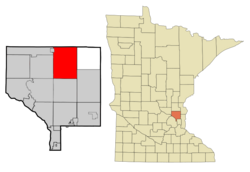City in Minnesota, United States City in Minnesota, United States
| East Bethel | |
|---|---|
| City | |
 Location of the city of East Bethel Location of the city of East Bethelwithin Anoka County, Minnesota | |
| Coordinates: 45°21′20″N 93°12′14″W / 45.35556°N 93.20389°W / 45.35556; -93.20389 | |
| Country | United States |
| State | Minnesota |
| County | Anoka |
| Incorporated (village) | June 7, 1957 |
| Incorporated (city) | January 1, 1974 |
| Area | |
| • Total | 47.69 sq mi (123.52 km) |
| • Land | 44.58 sq mi (115.46 km) |
| • Water | 3.11 sq mi (8.06 km) |
| Elevation | 909 ft (277 m) |
| Population | |
| • Total | 11,786 |
| • Density | 264.38/sq mi (102.08/km) |
| Time zone | UTC-6 (Central (CST)) |
| • Summer (DST) | UTC-5 (CDT) |
| ZIP codes | 55005, 55011, 55092 |
| Area code | 763 |
| FIPS code | 27-17486 |
| GNIS feature ID | 2394596 |
| Website | www.ci.east-bethel.mn.us |
East Bethel is a city in Anoka County, Minnesota, United States. The population was 11,786 at the 2020 census.
Minnesota State Highway 65 and Anoka County Road 22 are the main routes in the city. Highway 65 runs north–south, and County Road 22 (Viking Boulevard) runs east–west.
Geography
According to the United States Census Bureau, the city has an area of 47.97 square miles (124.24 km), of which 44.80 square miles (116.03 km) is land and 3.17 square miles (8.21 km) is water.
East Bethel is in the northern part of Anoka County. The city contains the primary site of the Cedar Creek Ecosystem Science Reserve
Central Minneapolis is 26 miles (42 km) to the southeast, along the Mississippi River, with the nearest international airport at Minneapolis–Saint Paul, 34 miles (52 km) southeast.
Adjacent cities
- Columbus (southeast)
- Ham Lake (south)
- Andover (southwest)
- Oak Grove (west)
- St. Francis (northwest)
- Bethel (northwest)
The neighborhood of Coopers Corner is in northern East Bethel, and the neighborhood of Coon Lake Beach is in southeastern East Bethel.
History
Linwood Township split from Bethel Township in 1871.
East Bethel was incorporated as a village on June 7, 1957, and was incorporated as the city of East Bethel on January 1, 1974.
The current boundaries of the City of East Bethel belonged to the Chippewa Indians until 1837, when the United States bought their lands east of the Mississippi River in what was later to become the State of Minnesota. Settlers began arriving in the area in the 1850s and the area was incorporated as a Township in 1858, the same year Minnesota was admitted to the Union. The Township was originally incorporated as the Township of Bethel, the name derived from the Bible and meaning the "House of God."
Situated in the northeast portion of Anoka County, the Quakers were the first settlers in Bethel in 1856. The group quickly established a school and a church, but left the area following the Indian Massacre of 1862. The Quakers took their families to Anoka and Minneapolis and never returned to the area. Other settlers that left during the Indian Wars did return to the area and became farmers, tradesmen, and merchants. The Township of Bethel exhibited a slow but steady growth from 423 in 1880 to 1,286 in 1957.
In spring of 1957, a local committee was formed to take the necessary legal steps to incorporate. On May 3, 1957, the petition was presented to the Anoka County Board of Commissioners and, as a result of the required election, incorporation was approved by 232 to 161 vote. This vote was challenged and the matter eventually was sent to the Minnesota Supreme Court and finally to the State Legislature for validation. East Bethel was officially incorporated as a Village on April 27, 1959 and as a City on January 1, 1974.
The City is approximately 48 square miles, which makes it the third largest City in the metro area in terms of size. As of the 2010 Census, there were 11,626 people residing in the City, comprising 4,060 households and 3,221 families. The population density is 259.5 inhabitants per square mile and there are 4,237 housing units at an average density of 94.6 per square mile.
Demographics
| Census | Pop. | Note | %± |
|---|---|---|---|
| 1860 | 128 | — | |
| 1870 | 216 | 68.8% | |
| 1880 | 423 | 95.8% | |
| 1890 | 419 | −0.9% | |
| 1900 | 617 | 47.3% | |
| 1910 | 617 | 0.0% | |
| 1920 | 682 | 10.5% | |
| 1930 | 668 | −2.1% | |
| 1940 | 680 | 1.8% | |
| 1950 | 913 | 34.3% | |
| 1960 | 1,408 | 54.2% | |
| 1970 | 2,586 | 83.7% | |
| 1980 | 6,626 | 156.2% | |
| 1990 | 8,050 | 21.5% | |
| 2000 | 10,941 | 35.9% | |
| 2010 | 11,626 | 6.3% | |
| 2020 | 11,786 | 1.4% | |
| U.S. Decennial Census | |||
City Leadership
Current leadership of the city includes the following people:
City Administrator - Matt Look
Mayor - Kevin Lewis
4 Council Members listed below:
Bob DeRoche
Tim Miller
Jim Smith
Brian Mundle
2010 census
As of the census of 2010, there were 11,626 people, 4,060 households, and 3,221 families living in the city. The population density was 259.5 inhabitants per square mile (100.2/km). There were 4,237 housing units at an average density of 94.6 per square mile (36.5/km). The racial makeup of the city was 95.9% White, 0.4% African American, 0.5% Native American, 1.6% Asian, 0.3% from other races, and 1.3% from two or more races. Hispanic or Latino of any race were 1.0% of the population.
There were 4,060 households, of which 39.6% had children under the age of 18 living with them, 66.9% were married couples living together, 6.6% had a female householder with no husband present, 5.8% had a male householder with no wife present, and 20.7% were non-families. 14.4% of all households were made up of individuals, and 3.6% had someone living alone who was 65 years of age or older. The average household size was 2.86 and the average family size was 3.15.
The median age in the city was 38.6 years. 26.2% of residents were under the age of 18; 7.9% were between the ages of 18 and 24; 26.8% were from 25 to 44; 31.9% were from 45 to 64; and 7% were 65 years of age or older. The gender makeup of the city was 52.2% male and 47.8% female.
2000 census
As of the census of 2000, there were 10,941 people, 3,607 households, and 2,936 families living in the city. The population density was 243.9 inhabitants per square mile (94.2/km). There were 3,718 housing units at an average density of 82.9 per square mile (32.0/km). The racial makeup of the city was 97.55% White, 0.19% African American, 0.43% Native American, 0.45% Asian, 0.32% from other races, and 1.06% from two or more races. Hispanic or Latino of any race were 0.95% of the population.
There were 3,607 households, out of which 47.2% had children under the age of 18 living with them, 70.6% were married couples living together, 6.1% had a female householder with no husband present, and 18.6% were non-families. 13.6% of all households were made up of individuals, and 2.8% had someone living alone who was 65 years of age or older. The average household size was 3.03 and the average family size was 3.33.
In the city, the population was spread out, with 32.1% under the age of 18, 6.9% from 18 to 24, 36.9% from 25 to 44, 20.0% from 45 to 64, and 4.0% who were 65 years of age or older. The median age was 33 years. For every 100 females, there were 108.1 males. For every 100 females age 18 and over, there were 109.5 males.
The median income for a household in the city was $57,880, and the median income for a family was $62,004. Males had a median income of $40,599 versus $27,377 for females. The per capita income for the city was $21,087. About 2.2% of families and 3.8% of the population were below the poverty line, including 4.1% of those under age 18 and 8.3% of those age 65 or over.
Transportation
References
- ^ "Guide to East Bethel Minnesota".
- ^ Upham, Warren (2001). Minnesota Place Names: A Geographical Encyclopedia. Minnesota Historical Society Press. p. 25. ISBN 9780873513968.
- "2020 U.S. Gazetteer Files". United States Census Bureau. Retrieved July 24, 2022.
- ^ U.S. Geological Survey Geographic Names Information System: East Bethel, Minnesota
- "2010 Census Redistricting Data (Public Law 94-171) Summary File". American FactFinder. U.S. Census Bureau, 2010 Census. Retrieved April 23, 2011.
- "US Gazetteer files 2010". United States Census Bureau. Archived from the original on July 2, 2012. Retrieved November 13, 2012.
- Distances according to Google Maps Accessed 17 February 2013
- "Coon Lake Beach · East Bethel, MN 55092". Coon Lake Beach · East Bethel, MN 55092. Retrieved September 15, 2022.
- POPULATION OF CIVIL DIVISIONS LESS THAN COUNTIES
- "History of East Bethel | East Bethel, MN - Official Website". www.ci.east-bethel.mn.us. Retrieved February 16, 2024.
- United States Census Bureau. "Census of Population and Housing". Retrieved August 14, 2013.
- "Administration | East Bethel, MN - Official Website". www.ci.east-bethel.mn.us. Retrieved February 16, 2024.
- "East Bethel hires Anoka County Board Chair Matt Look as city administrator". Star Tribune. November 14, 2023. Retrieved February 16, 2024.
- "City Council | East Bethel, MN - Official Website". www.ci.east-bethel.mn.us. Retrieved February 16, 2024.
- "East Bethel mayor resigns". June 13, 2023.
- "City Council | East Bethel, MN - Official Website".
- "DeRoche appointed to East Bethel City Council". June 29, 2023.
- "U.S. Census website". United States Census Bureau. Retrieved November 13, 2012.
External links
| Municipalities and communities of Anoka County, Minnesota, United States | ||
|---|---|---|
| County seat: Anoka | ||
| Cities |  | |
| Township | ||
| CDP | ||
| Unincorporated community | ||
| Ghost towns/Neighborhoods | ||
| Footnotes | ‡This populated place also has portions in an adjacent county or counties | |